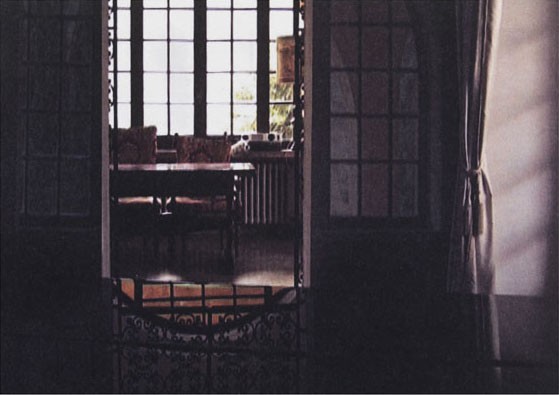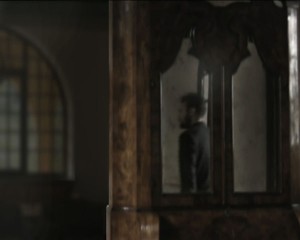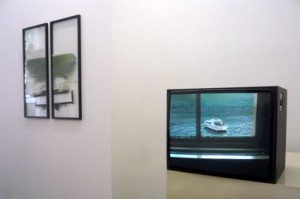An Interview with Daniel Laufer
You can buy a wide variety of works of art from our art vending machine. One such piece is a postcard by Daniel Laufer (*1975, Hanover).
The card shows a film still from the video, “The Fourth Wall” (at 08:13 min). The story is based on an Hasidic parable about two men who are supposed to design one half of a house. While the first man does his work with zeal, the second delays, uninspired. The second man, who is certain that he won’t come up with a better idea than his rival, decides to coat his work with black bitumen. The material will reflect the other half of the house like a mirror. Thus he discovers a good solution to avoid defeat.

Postcard with still shot from the film “The Fourth Wall” by Daniel Laufer
© Jewish Museum Berlin, photo: Jens Ziehe
The film was shown this year at the 14th Videonale at the Bonn Art Museum.
In the following interview, Daniel Laufer talks about the genesis and message of his postcard.
Christiane Bauer: Daniel, you work mostly in video form. Yet you produced a postcard for the art vending machine. Why did you choose this format?
Daniel Laufer: A postcard is something mobile that you can take with you. It connects you to something: it provides information and contains a message. It can be a souvenir – but with a statement. And I also like the fact that you can hang it on the wall.
The original work of art is an entire film. Why did you choose this particular shot as a motif for the postcard?
The scene shows innumerable mirrors. At first glance they’re only vaguely perceptible, and it’s hard to differentiate reality from reflection. In the end everything might be a reflection. Look at the black surface in the foreground: that’s a grand piano reflecting the window, which you can also see reflected by the mirror on the wall. There are two places in the film where you see these mirror surfaces for what they are. Otherwise you can’t tell them apart from reality. The postcard shows the point in the film where you realize: from this moment on, everything could be a reflection. This one film still captures the essence of the entire parable.
What gave you the idea of turning this Hasidic parable into a film?
I liked the parable because you can adapt it to the subject of the reception of art. Many people would probably think that the man who really struggled and worked hard should get paid for it. And the man who just covered his side with shiny black material to reflect the other half, he achieved less and should leave empty-handed. Looking at this assumption can sensitize the audience to the question, “What do we consider art?”
Although it’s less work to create this mirror from black bitumen, we shouldn’t underestimate the mental and creative work involved: the mirror reflects everything in the other room, not only now but in the future. In this way it becomes a perfect work of art. Not even a very beautiful painting can achieve this because it always only shows what was. It will never be able to depict anything more.
I also find the parable significant, because its author, rabbi Nachman, has been an important inspiration to me. Rabbi Nachman, the grandson of Baal Shem Tov, wrote a number of stories that can be read as spiritual vehicles. Traditionally they’re told aloud, and as you listen and think about them you enter into a spiritual process. Usually the stories offer different approaches to life that exceed religious structures. This fascinates me.
How did you put the film together?
I work with two media jointly: painting and film. For my films – and also for my installations – I work with the principle of “Matte Painting,” which is to say, I place a transparent glass frame in front of a background, such as a landscape, and I paint additional elements on the glass. Then I film through the sheets of glass that I’ve layered on top of each other. The painted and real parts blend together into one picture. I’ve been developing this technique further and now always work with an installation consisting of film and very large glass frames.
Where can we see your work in the future?
I have a catalogue presentation at art cologne this coming year (from 9 to 13 April 2014) and three solo exhibitions:
Glasmoog KHM, Cologne, 14 March to 4 May 2014
Kunstverein Harburger Bahnhof, Hamburg, end of October 2014
KM Galerie, Berlin, middle of November 2014
Thank you, Daniel, for the discussion and best wishes on your next projects!
Christiane Bauer, Exhibitions

